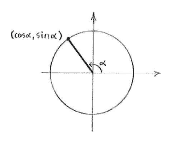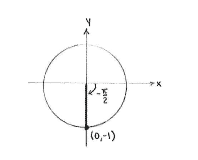Lösung 4.2:3a
Aus Online Mathematik Brückenkurs 1
(Unterschied zwischen Versionen)
K (hat „Solution 4.2:3a“ nach „Lösung 4.2:3a“ verschoben: Robot: moved page) |
|||
| Zeile 1: | Zeile 1: | ||
| - | + | Nachdem die trigonometrischen Funktionen von Winkeln die nicht zwischen <math>0</math> und <math>{\pi }/{2}\;</math> liegen durch den Einheitskreis definiert sind, verwenden wir den Einheitskreis. Der Punkt auf dem Einheitskreis der den Winkel <math>\alpha</math> zur ''x''-Achse bildet, hat einen ''x''-Koordinaten entsprechend <math>\cos \alpha</math> und einen 'y''-Koordinaten entsprechend <math>\sin \alpha</math>. | |
[[Image:4_2_3_a1.gif|center]] | [[Image:4_2_3_a1.gif|center]] | ||
| - | In | + | In unseren Fall sehen wir direkt dass <math>\sin\Bigl(-\frac{\pi}{2}\Bigr) = -1\,</math>. |
[[Image:4_2_3_a2.gif|center]] | [[Image:4_2_3_a2.gif|center]] | ||
Version vom 12:20, 4. Apr. 2009
Nachdem die trigonometrischen Funktionen von Winkeln die nicht zwischen \displaystyle 0 und \displaystyle {\pi }/{2}\; liegen durch den Einheitskreis definiert sind, verwenden wir den Einheitskreis. Der Punkt auf dem Einheitskreis der den Winkel \displaystyle \alpha zur x-Achse bildet, hat einen x-Koordinaten entsprechend \displaystyle \cos \alpha und einen 'y-Koordinaten entsprechend \displaystyle \sin \alpha.
In unseren Fall sehen wir direkt dass \displaystyle \sin\Bigl(-\frac{\pi}{2}\Bigr) = -1\,.


